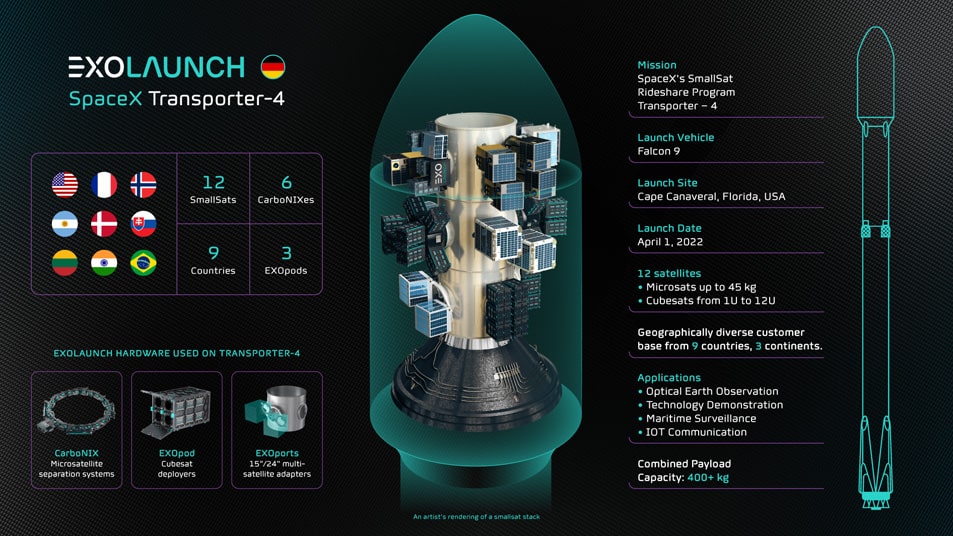TRANSPORTER-4 MISSION
FALCON 9
1st April 2022

Fourth dedicated rideshare mission with SpaceX
Mission
SpaceX's SmallSat
Rideshare Program
Transporter - 4
Launch site
Space Launch Complex 40, Cape Canaveral Space Force Station, Florida
Launch Vehicle
Falcon 9
Launch Period
April 2022
12 satellites
Main payload
Smallsat rideshare mission with 40 spacecraft, including CubeSats, microsats, picosats, non-deploying hosted payloads, and an orbital transfer vehicle

12 satellites
Launch site
Space Launch Complex 40, Cape Canaveral Space Force Station, Florida
Main payload
Smallsat rideshare mission with 40 spacecraft, including CubeSats, microsats, picosats, non-deploying hosted payloads, and an orbital transfer vehicle
Mission overview
In its fourth dedicated rideshare mission with SpaceX, Exolaunch, the leading global provider of launch, in-space logistics and deployment services, integrated and launched 12 small satellites from customers across the globe.
The mission lifted off on April 1, 2022 at 16.24 UTC from Cape Canaveral on 'Transporter-4' mission. This mission brought the total number of satellites sent to space by Exolaunch to over two hundred.The Falcon 9 launch was performed in the interests of the company's new and returning customers such as NanoAvionics, Norwegian Defence Research Establishment (FFI), UNSEENLABS, Omnispace, Thales Alenia Space, Satellogic, Pixxel, Spacemanic and the University of Brasilia (UnB). With small satellite deployment into two different orbits on a single mission of Falcon 9 and the debut flight of the newest CarboNIX 8-inch microsat separation system, this was the most trailblazing Transporter mission yet for Exolaunch.
The mission is the fourth Transporter mission in a series of rideshare launches, which Exolaunch has manifested on Falcon 9 under a Multi-Launch Agreement with SpaceX first signed in 2020 and extended at the end of 2021. For each Falcon 9 launch procured through the Multi-Launch Agreement, Exolaunch provided a turnkey solution encompassing comprehensive rideshare mission management, satellite integration, environmental testing and deployment services. Exolaunch has deployed nearly 100 microsats and cubesats on SpaceX's first three record-breaking dedicated rideshare Transporter missions.
To maximize payload capacity and cost-effectiveness for their customers, Exolaunch used its recent product addition, EXOport, a flexible multi-satellite adapter designed to optimally accommodate microsats and cubesats on a single Falcon 9 port. Exolaunch also used its proprietary flight-proven separation systems CarboNIX, a next generation shock-free separation system with 100% reliability, that to date has successfully separated 30 microsats, and the EXOpod, Exolaunch's cubesat deployer with a heritage of 145 deployed satellites.
Exolaunch's manifest on the Transporter-4 mission included the following payloads and companies:
-
SPARK 1 from Omnispace (USA)
Designed and built by Thales Alenia Space in conjunction with NanoAvionics, Syrlinks & ANYWAVES, this new-generation NGSO satellite will operate in the 2 GHz S-band. Omnispace Spark 1 will support the mobile industry 3GPP standard, making connectivity possible direct to compatible devices. This program will serve to advance the development and implementation of Omnispace's global hybrid non-terrestrial (NTN) network.
-
MP42 from NanoAvionics (USA, UK & Lithuania)
The first ring-deployed microsat of NanoAvionics carrying payloads from 5 different companies. The hardware and software of MP42 satellite bus, as well as mission operations infrastructure, are established on baseline architecture and mission-specific “building blocks” for flexible, time- & cost-efficient integration, resulting in wide applicability, reliability, repeatability, and manufacturability.
-
SHAKUNTALA from Pixxel (USA & India)
Is a hyperspectral Earth imaging satellite. The constellation is designed to provide global coverage every 24 hours, with the aim of detecting, monitoring and predicting global phenomena.
-
BDSAT from Spacemanic (Slovak Republic) and BD Sensors (Czech Republic)
BDsat project aims to support the radio amateur community with several HAM services and activities. Secondary goal is a verification of a prototype of pressure measuring equipment and to verify the functionality of this technology in open space conditions.
-
ALFACRUX from the University of Brasilia (Brazil)
Developed by UnB and manufactured by Alen Space, the AlfaCrux satellite is designed for educational and technical investigations of narrowband communication and its applications carried out by researchers, students, and amateur radio operators interested in radio technique without pecuniary interest. Possible in-orbit technical demonstrations include digipeater solutions, scintillation impacts in the satellite communication link, and data collection systems.
-
BRO-7 from UNSEENLABS (France)
The seventh satellite of UNSEENLABS' constellation dedicated to the geolocation of vessels at sea. UNSEENLABS processes and analyzes the RF data, and provides unique knowledge for national security operations, for environmental protection and for an increasing number of applications in the commercial sector. Their constellation is designed to provide data to clients to follow maritime traffic, regardless of the time of day and weather conditions.
-
ARCSAT from the Norwegian Defence Research Establishment (FFI) (Norway)
A GomSpace manufactured nanosatellite designed to demonstrate the use and relevance of a satellite relay for UHF communication at high latitudes. The satellite will be able to cover any point on the Earth's surface ranging from 4 up to 15 daily passes at higher latitudes from a polar orbit.
-
5 x NEWSAT MICROSATS from Satellogic (USA & Argentina)
The mission will include the first deployment of Satellogic's new Mark V satellite model. This new generation of satellites enhances the company's constellation with improved cameras, radios, computers, and other subsystems compatible with all components from previous models, offering Satellogic's customers higher quality products. The remaining satellites are four updated NewSats Mark IV. These improved satellites contain increased onboard storage and upgrades to the propulsion and navigation systems. This launch will expand Satellogic's fleet to 22 satellites delivering high-resolution data from space.
VIDEO © EXOLAUNCH
featured customers
Ready to go
to space?
Let's chat. Get in touch and we'll be with you shortly.









